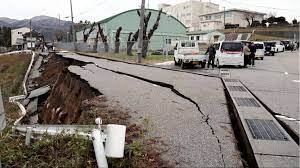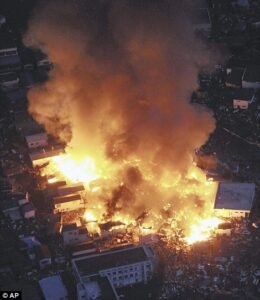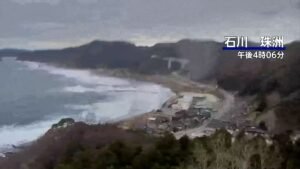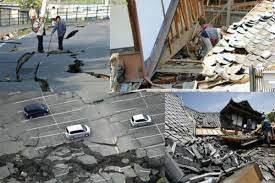On Monday, the New Year’s Eve, a 7.6-magnitude earthquake at roughly 16:10 local time (07:10 GMT), shaked Japan.
Approximately 144 aftershocks have been detected since the first one. They were followed with severe tsunami warnings across the coast. The powerful earthquake claimed the lives of at least 30 people. Many people are expected to be stuck under the rubble.
A day after caused tsunami waves more than one meter high struck the coast, the official stated that minor modifications to tide levels were still possible.
Japan’s New Year Quake Destruction
As the whole world was busy welcoming the New Year, a high intensity quake rocked the nation. Major damage to infrastructure is obvious, but the full scope of the disaster is unlikely to be known.
According to national network NHK, officials in Suzu City, Ishikawa prefecture, reported that numerous houses and transmission lines collapsed.
Hokuriku Electric Power confirmed major highways were closed close to the epicenter of the earthquake, leaving almost 36,000 households without power.
Reporting from Taiwan, former BBC Japan reporter Rupert Wingfield-Hayes claimed that a landslide had destroyed several hundred meters of the main highway connecting Toyama and Kanazawa.
Japanese rescuers are working round the clock to find any survivors under the mass debris of destruction caused by the quake.
In Shika, Tsugumasa Mihara, 73, told news agency AFP, “It was such a powerful jolt,” as he stood in line with hundreds of other people to get water. “What a terrible way to start the year,” startled the man.
Another old person told NHK, “There was shaking like I have never experienced before.” “It was awful inside my house… I’m still here. Perhaps I should just have to settle for that.”
Although there are multiple nuclear power plants in the impacted areas, there is “no risk of radioactivity leaking” from the facilities, according to Japan’s nuclear authorities.
Japanese Prime Minister Fumio Kishida told reporters, “Very extensive damage has been confirmed, including numerous casualties, building collapses, and fires,” adding that there was a “race against time” to save lives.
A huge fire broke out in Wajima city, Ishikawa Prefecture destroying over 50 buildings. The majority of ships, trains, and airplanes into the region have been suspended.
Tsunami alert & Japan’s Allies Concern
Tsunami warnings and advisories were shared, a day after 5 metres (16 feet) high waves were believed to be reaching Noto in Ishikawa Prefecture in the aftermath of the 7.6 magnitude quake. Following the earthquake, Russia and South Korea’s meteorological office also issued tsunami warnings.
The waves that actually crashed upon the Sea of Japan coastline in Ishikawa on Monday barely reached a height of one meter.
Later, the significant warning was modified to an advisory, then to a standard caution. Two other prefectures, Niigata and Toyama, were also under lockdown.

Following the tragedy, Tokyo has received support letters from Japan’s allies.
According to US President Joe Biden, his nation stood ready to provide support. The people of the United States and Japan are united by a strong friendship as close allies. During this trying time, our thoughts are with the people of Japan “added the speaker.
After the tragedy, Prime Minister Rishi Sunak declared that the UK was “ready to support Japan” and expressed his sympathies to “all those affected by the earthquakes in Japan which have caused such terrible damage.”
Emergency phone numbers for Indian nationals residing in the Japanese archipelago have been provided by the Indian Embassy in Japan. Additionally, the embassy has established a control room that Indians can use to contact in case of help.
More details are awaited for the numbers of the fatalities and destructions caused by the incident.











